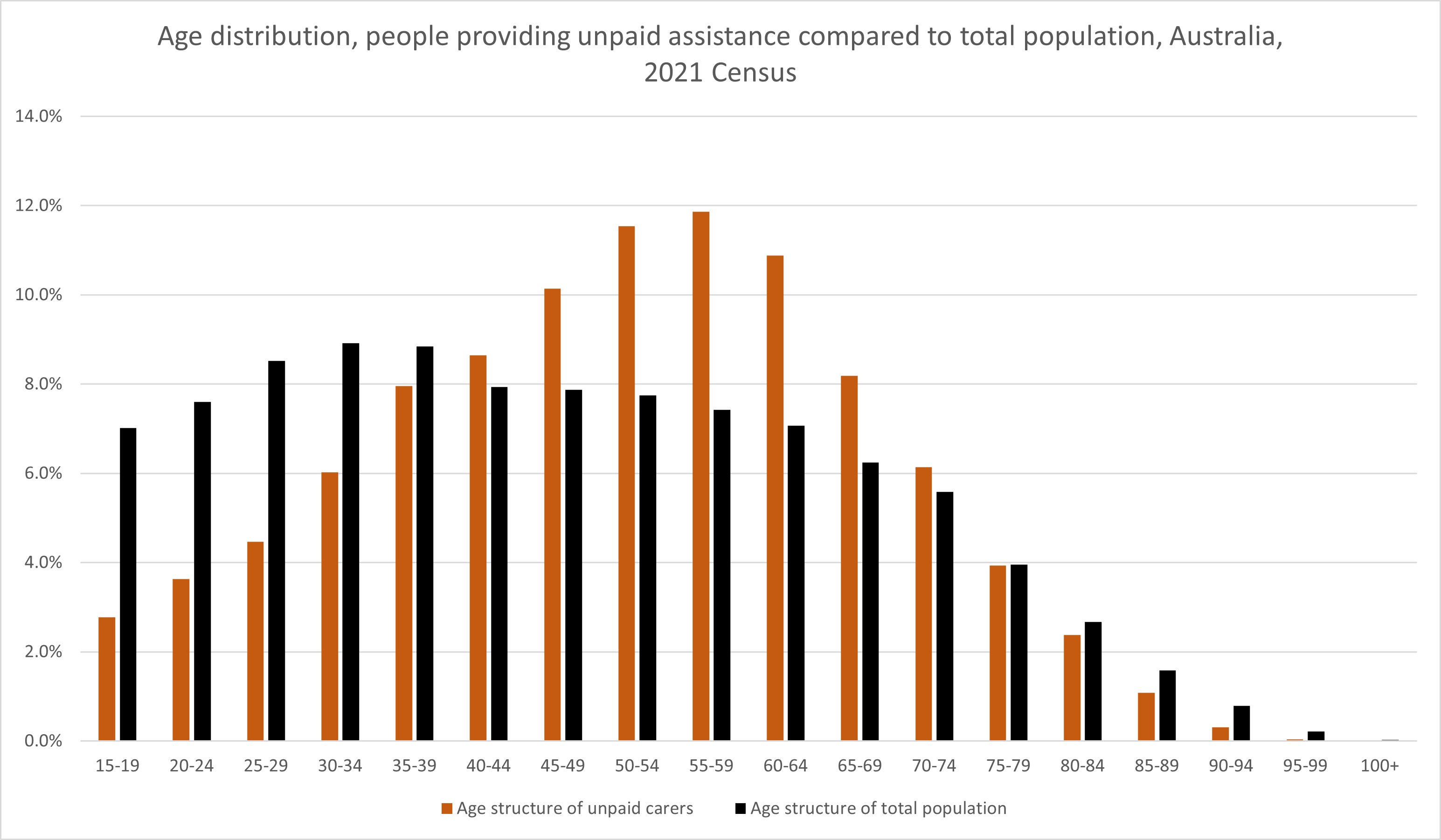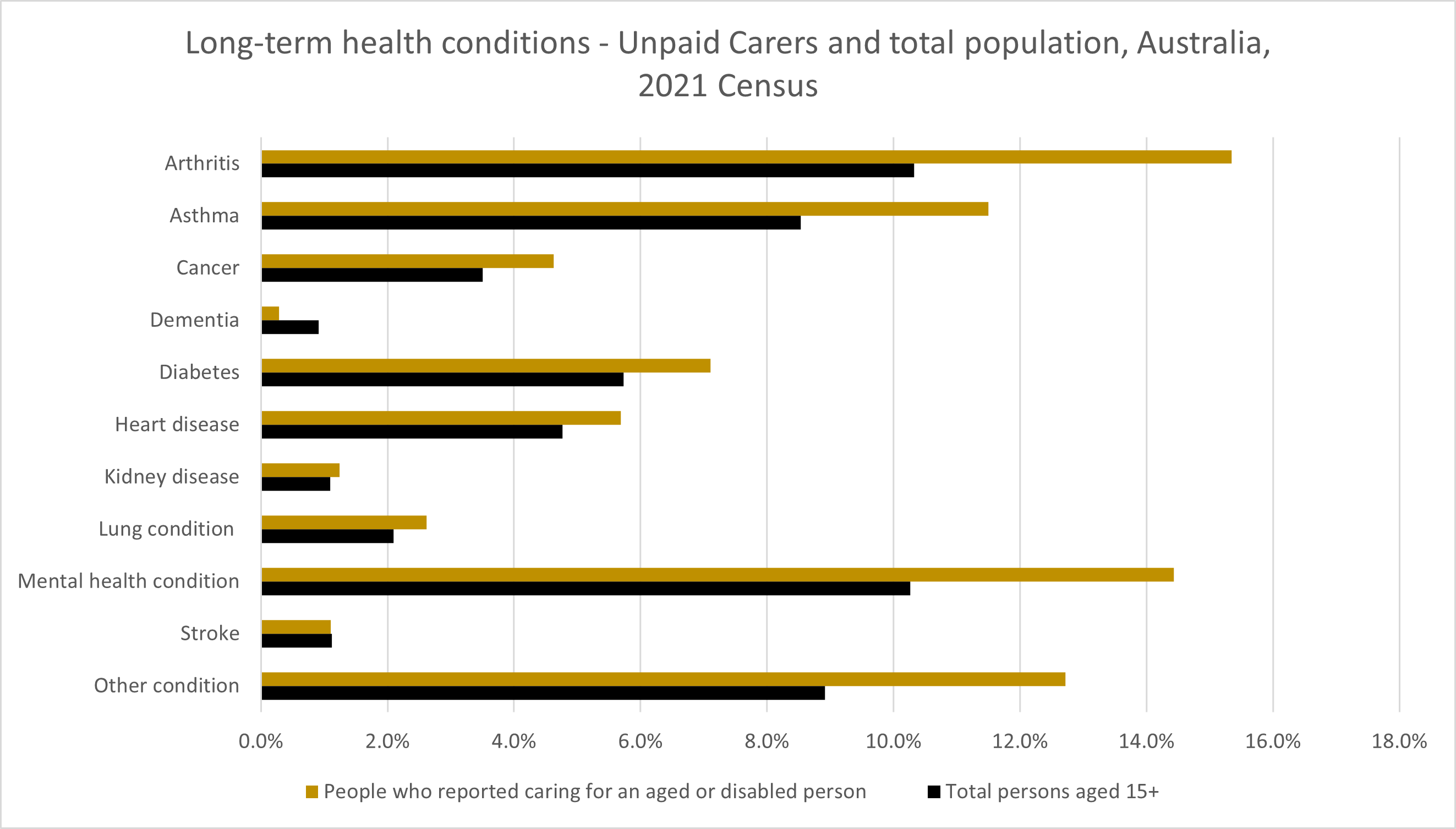A question on “Unpaid care to a person with a disability, health condition or due to old age” has been included on each Census since 2006. This article looks at how many people provide unpaid care within the community, and what their characteristics are.
The 2021 Census asked people to respond whether they provided unpaid care to a person with a disability, health condition, or old age and specifically refers to the two weeks prior to Census night (August 10th 2021). While the question about volunteering for an organisation or group was highly affected by the COVID pandemic, the unpaid care question was less affected, and shows a steady increase over time.
In 2021, just under 2.5 million people, or 11.9% of the population over 15, said that they provided unpaid care to an aged or disabled person. This was up by more than 330,000 from 11.3% in 2016, and has risen by almost a million people from 10.1% in 2006, when the question was first asked on the Census. There is little variation across the states and territories. The NT has the lowest rate (9.5%) and South Australia has the highest (13.1%). Broadly speaking, areas with older populations tend to have more carers, but not by a large margin.
Carers tend to be middle aged
The following chart shows that unpaid carers are mostly what we’d term “middle-aged”. There are carers in every age group, but the largest share of carers fall between the ages of 45 and 69 years. This accounts for 53% of all unpaid carers but makes up only 38% of total population over 15. This is perhaps not surprising, given it’s the age group most likely to have an elderly parent or relative in the 85+ age range. There are fewer young carers, but still sizeable numbers, while it tapers off a lot over the age of 80, when you’re more likely to be needing to receive care.

Source: Australian Bureau of Statistics (2021), Unpaid work and care: Census; chart by .id (informed decisions)
Non-English speaking background communities report unpaid care differently
Unpaid carers are also more likely to be born in Australia, and English speaking. In 2021, 71.5% of people who reported providing unpaid care were born in Australia, compared to 62.3% of the population over 15. And 78.4% used English at home, compared to 71.6% of all those aged over 15. This may be simply age-based (ie. English speaking and Australian born are more likely to be in the middle-aged groups) or may indicate a reporting bias in multicultural populations – perhaps some overseas-born communities provide support across a wider community and don’t interpret the question the same way as Australian-born English speakers.
Carers are more likely to be female and lower income
Carers are most commonly female, but not overwhelmingly so. Just more than 60% of those who said they had caring responsibilities in 2021 were female. This is similar to the proportion of those reporting child care responsibilities who are female.
Unpaid carers were also likely to be lower income, even when adjusted for smaller household size. The median equivalised household income for households containing a person providing unpaid care was $1,021/week Australia-wide, compared to $1,156/week for people counted in households who were not providing unpaid care.
Some carers need care themselves
Interestingly, unpaid carers were almost as likely to require assistance themselves as the general population. In 2021, 6.1% of people who provided unpaid care to a person with a disability had a need for assistance themselves (6.3% of the total population aged over 15). And they are much more likely to have a long-term health condition themselves (whether or not it required daily assistance), with 47.1% of carers reporting one or more long-term health conditions (36.2% of the total population over 15 reported the same). The most common conditions among carers were Arthritis and Mental Health – but all conditions except for Dementia and Stroke were more prevalent among carers than among the total population.

Source: Australian Bureau of Statistics (2021), Unpaid work and care: Census; chart by .id (informed decisions)
So the profile of an unpaid carer in Australia was most likely to be female, aged in their 50s to 60s, born in Australia and part of a slightly lower than average income household, with a higher than average rate of long-term health conditions.
Exploring carers information
You can find information on unpaid care under the “Care” heading of profile.id, which is in the “What do we do?” section. There is also an atlas map showing the distribution of carers in your community on atlas.id under the “Work” section – the map is called “Unpaid Carers”.

Check out profile.id for Australia here: https://profile.id.com.au/australia/unpaid-care
Access our profiles for LGAs around Australia →












